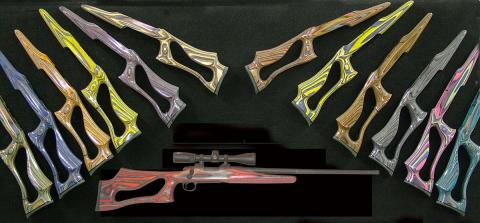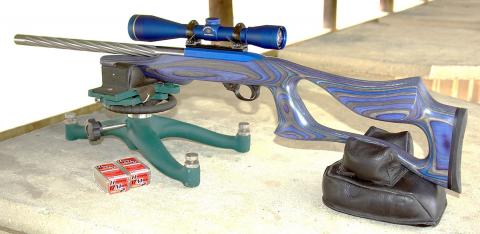
Prior to August 2014 when a disastrous fire totally destroyed the Rutland Plywood factory in Rutland, Vermont, this company was virtually the sole supplier of laminated blanks to most domestic firearms manufacturers, as well as after-market replacement stock purveyors. In fact, it was Rutland that developed the wood laminated rifle stock that we have come to know.
It all started back in the mid-1980s when Jack Barrett, Rutland’s CEO and an avid hunter and gun enthusiast, began experimenting with various laminates in an effort to find one that would excel at being a rifle stock. That meant a medium that was stable under all climatic and weather conditions; one that wouldn’t shrink, swell or warp, all of which affect accuracy and the ability to maintain zero.
Laminates are also infinitely stronger than conventional one-piece stocks, regardless of wood type. The thinner these sheets or veneers are, the more the finished stock takes on an attractive layering look resembling a contour map. When the veneers are stacked in alternating colors, the visual effect can be quite stunning. In addition to the visual appeal, a laminated stock has the warmth and feel of real wood…because it is real wood.

The Rutland laminated stock made its debut at the 1987 SHOT Show where Ruger, Savage, Thompson-Center and Winchester all displayed examples of their flagship rifles wearing colorful Rutland laminated stocks. The rest is pretty much history. Several companies have since come forth to fill the void, but it was Rutland who set the bar, and no one since has raised it…until now.

Rutland is back, and with a new laminate they claim is superior to the original. To achieve that, Jack Barrett decided to not start from Square One by building another huge manufacturing complex where in the past he controlled the production process from the felled tree to the finished blank. Instead, he joined forces with Besse Forest Products Group, a US company which Barrett says supply veneers of even higher quality and to tighter tolerances than the ones Rutland produced before the fire. He also says his new laminating process uses a formaldehyde-free resin (CARB compliant) that produces an even stronger bond than before, which is saying something because years ago when touring the old Rutland factory, Jack handed me a hammer and chisel and asked me to try to split a blank along a seam. I couldn’t. The chunks I was able to split off always ripped across seams, never along one!
One of two new Rutland products is called PowerCore where the typical longitudinal grain direction is modified in the critical recoil lug and pistol grip areas which, according to Barrett, increases strength and stiffness 3-5 times compared to a standard laminate. PowerCore is currently being used by RUGER for one of their high performance long range rifles.
Also new is Rutland’s patenting of a new process whereby the blanks undergo several re-laminations, which results in a highly distinctive chevron pattern of layering unlike any laminated stock on the market today. In fact, they’re calling it ChevCore (patent pending) and you can see what it looks like in the accompanying photos. I’m thinking that next year we’re going to be seeing these highly distinctive stocks on some very familiar rifles. Barrett says he believes ChevCore will define the future of laminated stocks in the firearms industry.–Jon R. Sundra
